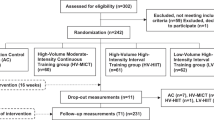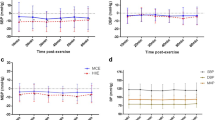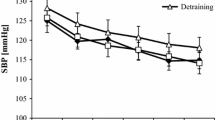Abstract
In patients with chronic heart failure (CHF) blood pressure (BP) control, represents a relevant target of management. This study evaluated the effect of different intensities exercise training on 24-h ambulatory BP profile and insulin resistance in patients with CHF. Thirty-six CHF patients with left ventricular ejection fraction <40 %, were randomized to high-intensity interval training (HIT) or moderate continuous training (MIT) for 12 weeks. HIT consisted in treadmill exercise at ~75–80 % of heart rate reserve (HRR), alternated with active pauses at 45–50 % of HRR. MIT consisted in continuous treadmill at ~45–60 % of HRR. Peak VO2 and anaerobic threshold increased significantly with both HIT and MIT, without significant differences between the two training programs. 24-h, systolic and diastolic BP decreased with both HIT and MIT. The same occurred for day-time and night-time systolic and diastolic BP. The decrease in day-time diastolic BP was slightly but significantly greater in HIT. Both HIT and MIT induced a significant decrease in fasting glucose and insulin, whereas HOMA-IR decreased significantly only after HIT. In patients with CHF exercise training reduces BP throughout the day, without substantial differences between moderate and more vigorous exercise intensity, with a small exception for day-time diastolic BP. HIT was more effective in improving insulin resistance.
Similar content being viewed by others
References
Fagard RH, Cornelissen VA (2007) Effect of exercise on blood pressure control in hypertensive patients. Eur J Cardiovasc Prev Rehabil 14:12–17
Mancia G, De Backer G, Dominiczak A, Cifkova R, Fagard R, Germano G et al (2007) Guidelines for the management of arterial Hypertension. The task force for the management of arterial hypertension of the European Society of Hypertension (ESH) and of the European Society of Cardiology (ESC). Eur Heart J 28:1462–1536
Pina IL, Apstein CS, Balady GJ, Belardinelli R, Chaitman BR, Duscha BD et al (2003) Exercise and heart failure. A statement from the American Heart Association Committee on Exercise, Rehabilitation, and Prevention. Circulation 107:1210–1225
Piepoli MF, Corrà U, Benzer W, Bjarnason-Wehrens B, Dendale P, Gaita D et al (2010) Secondary prevention through cardiac rehabilitation: from knowledge to implementation. A position paper from the cardiac rehabilitation section of the European Association of Cardiovascular Prevention and Rehabilitation. Eur J Cardiovasc Prev Rehabil 17:1–17
Davies EJ, Moxham T, Rees K, Singh S, Coats AJS, Ebrahim S et al (2010) Exercise training for systolic heart failure: cochrane systematic review and meta-analysis. Eur J Heart Fail 12:706–715
Molmen-Hansen HE, Stolen T, Tjonna AE, Aamot IL, Ekeberg IS, Tyldum GA et al (2012) Aerobic interval training reduces blood pressure and improves myocardial function in hypertensive patients. Eur J Prev Cardiolog 19:151–160
Lamina S (2010) Effects of continuous and interval training programs in the management of hypertension: a randomized controlled trial. J Clin hypertens 12:841–849
McMurray JJV, Adamopoulos S, Anker SD, Auricchio A, Bohm M, Dickstein K et al (2012) ESC Guidelines for the diagnosis and treatment of acute and chronic heart failure 2012: The Task Force for the Diagnosis and Treatment of Acute and Chronic Heart Failure 2012 of the European Society of Cardiology. Developed in collaboration with the Heart Failure Association (HFA) of the ESC. Eur Heart J 33:1787–1847
Wisloff U, Stoylen A, Loennechen JP, Bruvold M, Rognmo Ø, Haram PM et al (2007) Superior cardiovascular effect of aerobic interval training versus moderate continuous training in heart failure patients. Circulation 15:3086–3094
Iellamo F, Manzi V, Caminiti G, Vitale C, Castagna C, Massaro M et al (2012) Matched dose interval and continuous exercise training induce similar cardiorespiratory and metabolic adaptations in patients with heart failure. Int J Cardiol. doi:10.1016/j.ijcard.2012.06.057
Mallion JM, Baguet JP, Mancia G (2006) European Society of Hypertension Scientific Newsletter: clinical value of ambulatory blood pressure monitoring. J Hypertens 24:2327–2330
Verdecchia P (2000) Prognostic value of ambulatory blood pressure: current evidence and clinical implication. Hypertension 35:844–851
Dolan E, Stanton A, Thijs L, Hinedi K, Atkins N, McClory S et al (2005) Superiority of ambulatory over clinic blood pressure measurement in predicting mortality. The Dublin outcome study. Hypertension 46:156–161
Doehner W, Rauchhaus M, Ponikowski P, Godsland IF, von Haehling S, Okonko DO et al (2005) Impaired insulin sensitivity as an independent risk factor for mortality in patients with stable chronic heart failure. J Am Coll Cardiol 46:1019–1026
Ingelsson E, Sundstrom J, Amlov J, Zethelius B, Lind L (2005) Insulin resistance and risk of congestive heart failure. JAMA 294:334–341
Swan JW, Anker SD, Walton C, Godsland IF, Clark AL, Leyva F et al (1997) Insulin resistance in chronic heart failure: relation to severity and etiology of heart failure. J Am Coll Cardiol 30:527–532
Scherrer U, Sartori C (1997) Insulin as a vascular and sympathoexcitatory hormone. Implications for blood pressure regulation, insulin sensitivity, and cardiovascular morbidity. Circulation 96:4104–4113
Nishiyama Y, Minohara M, Hirai Y, Ohe M, Katoh A, Miyamoto T et al (2006) Effect of physical training on insulin resistance in patients with chronic heart failure. Circulation J 70:864–867
Matthews DR, Hosker JP, Rudenski AS, Naylor BA, Treacher DF, Turner RC (1985) Homeostasis model assessment: insulin resistance and ß-cell function from fasting plasma glucose and insulin concentrations in man. Diabetologia 28:412–419
Warburton DAR, McKenzie DC, Haykowsky MJ, Taylor A, Shoemaker P, Ignaszewski AP et al (2005) Effectiveness of high-intensity interval training for the rehabilitation of patients with coronary artery disease. Am J Cardiol 95:1080–1084
Rognmo O, Hetlandb E, Helgerudb J, Hoffb J, Slørdahla SA (2004) High-intensity aerobic interval exercise is superior to moderate-intensity exercise for increasing aerobic capacity in patients with coronary artery disease. Eur J Cardiovasc Prev Rehabil 11:216–221
Elley CR, Arroll B (2006) Refining the exercise prescription for hypertension. Lancet 366:1248–1249
Cornelissen VA, Fagard RH (2005) Effects of endurance training on blood pressure, blood pressure-regulating mechanisms, and cardiovascular risk factors. Hypertension 46:667–675
Crimi E, Ignarro LJ, Cacciatore F, Napoli C (2009) Mechanisms by which exercise training benefits patients with heart failure. Nat Rev Cardiol 6:292–300
Kemppainen J, Tsuchida H, Stolen K, Karisson H, Bjomholm M, Heinonen OJ et al (2003) Insulin signalling and resistance in patients with chronic heart failure. J Physiol 550:305–315
Sabelis LW, Senden PJ, Te Boekhorst BC, Hulzebos HJ, Van De Wiel A, Van Haeften TW et al (2004) Does physical training increase insulin sensitivity in chronic heart failure patients? Clin Sci 106:459–466
Conflict of interest
None.
Author information
Authors and Affiliations
Corresponding author
Rights and permissions
About this article
Cite this article
Iellamo, F., Caminiti, G., Sposato, B. et al. Effect of High-Intensity interval training versus moderate continuous training on 24-h blood pressure profile and insulin resistance in patients with chronic heart failure. Intern Emerg Med 9, 547–552 (2014). https://doi.org/10.1007/s11739-013-0980-4
Received:
Accepted:
Published:
Issue Date:
DOI: https://doi.org/10.1007/s11739-013-0980-4




